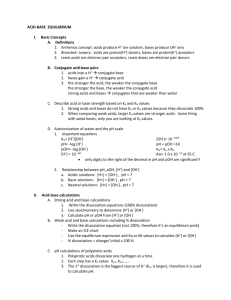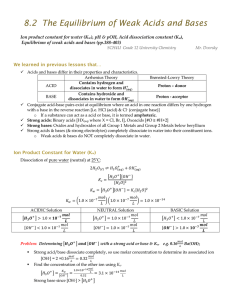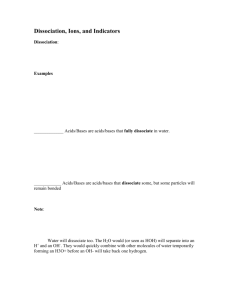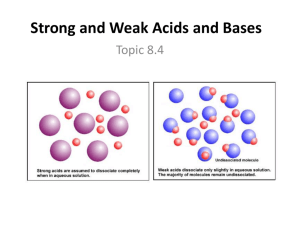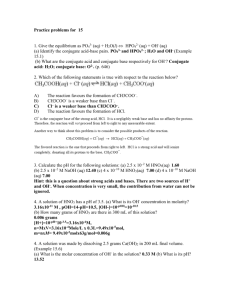K a and K b Handout
advertisement
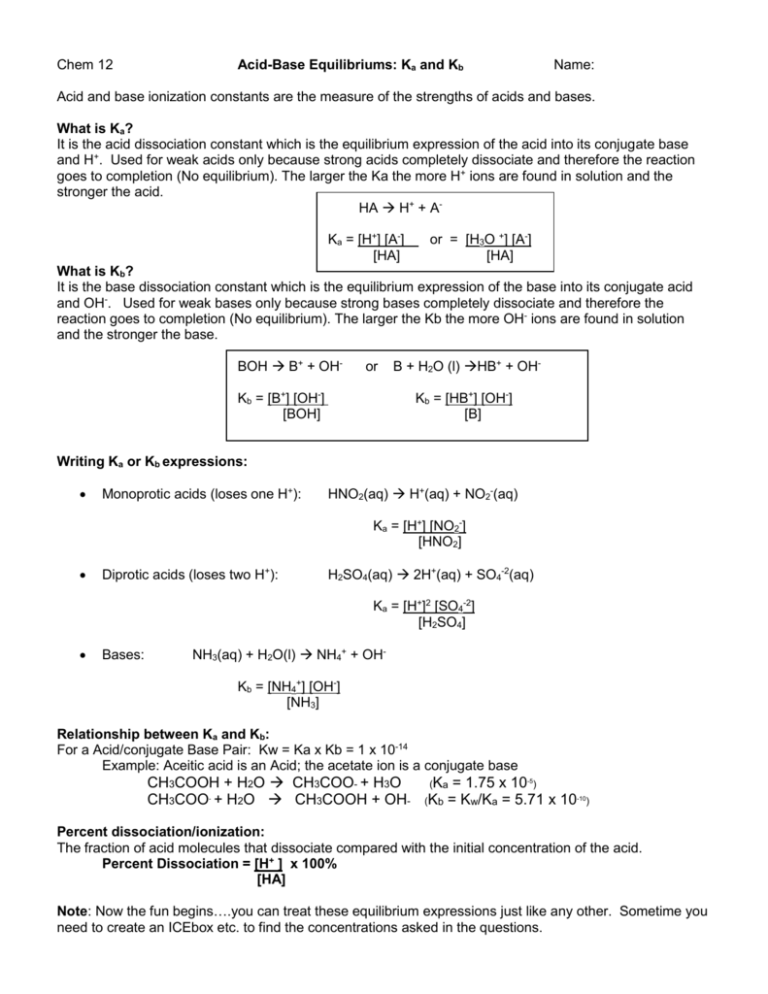
Chem 12 Acid-Base Equilibriums: Ka and Kb Name: Acid and base ionization constants are the measure of the strengths of acids and bases. What is Ka? It is the acid dissociation constant which is the equilibrium expression of the acid into its conjugate base and H+. Used for weak acids only because strong acids completely dissociate and therefore the reaction goes to completion (No equilibrium). The larger the Ka the more H+ ions are found in solution and the stronger the acid. HA H+ + AKa = [H+] [A-] [HA] or = [H3O +] [A-] [HA] What is Kb? It is the base dissociation constant which is the equilibrium expression of the base into its conjugate acid and OH-. Used for weak bases only because strong bases completely dissociate and therefore the reaction goes to completion (No equilibrium). The larger the Kb the more OH- ions are found in solution and the stronger the base. BOH B+ + OH- or B + H2O (l) HB+ + OH- Kb = [B+] [OH-] [BOH] Kb = [HB+] [OH-] [B] Writing Ka or Kb expressions: Monoprotic acids (loses one H+): HNO2(aq) H+(aq) + NO2-(aq) Ka = [H+] [NO2-] [HNO2] Diprotic acids (loses two H+): H2SO4(aq) 2H+(aq) + SO4-2(aq) Ka = [H+]2 [SO4-2] [H2SO4] Bases: NH3(aq) + H2O(l) NH4+ + OHKb = [NH4+] [OH-] [NH3] Relationship between Ka and Kb: For a Acid/conjugate Base Pair: Kw = Ka x Kb = 1 x 10-14 Example: Aceitic acid is an Acid; the acetate ion is a conjugate base CH3COOH + H2O CH3COO- + H3O CH3COO- + H2O CH3COOH + OH- (Ka = 1.75 x 10-5) (Kb = Kw/Ka = 5.71 x 10-10) Percent dissociation/ionization: The fraction of acid molecules that dissociate compared with the initial concentration of the acid. Percent Dissociation = [H+ ] x 100% [HA] Note: Now the fun begins….you can treat these equilibrium expressions just like any other. Sometime you need to create an ICEbox etc. to find the concentrations asked in the questions. Remember that weak acids/bases dissociate a very small amount: Often this dissociation has a negilable effect on the concentration weak acid or weak base. For problems that give the initial concentration of the acid and Ka: If [HA] > 500 (or [B] > 500) the change in the initial concentration of the acid can be ignored. Ka¸ Kb If [HA] < 500 (or [B] < 500) the change in the initial concentration of the acid must be included in Ka Kb calculations!!!! Sample Problem: a)Calculate the pH of a sample of vinegar that contains 0.83 mol/L acetic acid. B)What isthe percent dissociation of the vinegar, given that Ka = 1.8 × 10-5? Questions: 1. Write the Ka or Kb for the following: a) CH3COOH (acetic acid) b) NH4OH c) N2H4 d) HCOOH (formic acid) 2. Propanioc acid, CH2CH2COOH, is a weak acid that is used to inhibit mould formation in bread. A student prepared a 0.10 M solution of propanioc acid and found the pH was 2.96. What is the Ka of this acid? 3. Formic acid, HCOOH, is present in the sting of certain ants. What is the pH of a 0.025 M solution of formic acid? 4. A solution of hydrofluoric acid has a molar concentration of 0.0100 M. What is the pH of the solution? 5. An aqueous solution of household ammonia (NH3) has a molar concentration of 0.105M. Calculate the pH of the solution. 6. Morphine, C17H19NO3, is a naturally occurring base that is used tom control pain. A 4.5 x 10-3 M solution has a pH of 9.93. Calculate the Kb for morphine. Answers: 2) 1.2 x 10-5 3) 2.65 4) 2.65 5) 11.14 6) 1.6 x 10-6




